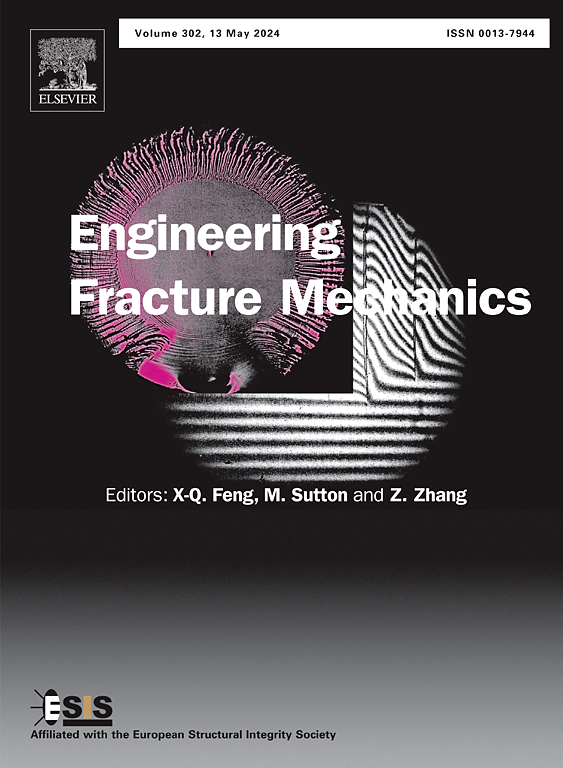各向同性和各向异性的影响:了解磁活性弹性体的断裂行为
IF 5.3
2区 工程技术
Q1 MECHANICS
引用次数: 0
摘要
磁活性弹性体(MAE)具有磁-机械耦合性,通常包含嵌入弹性体基质中的微米级球形铁磁性颗粒。通过在磁场中固化 MAE 材料,MAE 中的各向异性颗粒排列可提供定制的、比各向同性配置更强的磁机械耦合。虽然对有效模量和振动响应等可调 MAE 特性的研究相对较多,但对其断裂机制的透彻了解,尤其是对具有微结构各向异性的 MAE 或具有类似结构的复合材料的了解,仍几乎完全空白。在此,我们利用实验和模拟来描述各向异性和各向同性非磁化 MAE 的断裂机制,重点关注各向异性链状结构中球形颗粒的影响。具体来说,我们通过实验测量了含有不同体积分数颗粒的 MAE 的断裂韧性,这些颗粒既有随机排列的,也有与加载方向成 0°、45° 和 90° 排列的。结果表明,与纯弹性体相比,各向异性 MAE 的断裂韧性可提高近 600%,而各向同性 MAE 的断裂韧性仅提高 420%。对断裂后的表面进行扫描电子显微镜观察,可发现微观尺度的增韧机制,如链状波纹、颗粒聚集和颗粒分布。使用基于有限元法的去耦合相场-粘合区模型对简化几何形状进行模拟,定性地支持了成像解释。总之,这项工作解释了内部几何形状(包括颗粒链的波浪状、链排列和颗粒团聚)如何影响 MAE 和一般具有球形颗粒链状几何形状的软复合材料的断裂。这些结果在工程应用中可用于改善智能软复合材料的断裂性能,如软机器人、可调减震器和噪音衰减器。本文章由计算机程序翻译,如有差异,请以英文原文为准。
Effect of isotropy and anisotropy: toward understanding the fracture behavior of magnetoactive elastomers
Magnetoactive elastomers (MAEs) exhibit magneto-mechanical coupling and typically contain micron-sized spherical ferromagnetic particles embedded in an elastomeric matrix. Anisotropic particle arrangement in MAEs, achieved by curing the material in a magnetic field, offers tailored and enhanced magneto-mechanical coupling compared to isotropic configurations. While tunable MAE properties such as the effective modulus and vibrational response have been relatively well studied, a thorough understanding of their fracture mechanisms, particularly in MAEs with microstructural anisotropy or composites with similar structures remains almost completely unexplored. Here, we characterize the fracture mechanisms of anisotropic and isotropic unmagnetized MAEs using experiments and simulations, focusing on the effects of spherical particles in anisotropic chain-like configurations. Specifically, we experimentally measure the fracture toughness of MAEs containing different volume fractions of particles, and with particles arranged both randomly and aligned at 0°, 45°, and 90° to the loading direction. Results show that anisotropic MAEs with particle chains aligned with the load direction can improve fracture toughness by up to almost 600%, whereas isotropic MAEs increase the fracture toughness by only 420%, compared to the pure elastomer. Scanning electron microscopy of the post-fractured surface reveals toughening mechanisms at micro-scale, such as chain waviness, particle agglomeration, and particle distribution. Simulations using a finite element method-based decoupled phase field-cohesive zone model on simplified geometries qualitatively support imaging interpretations. Overall, this work explains how internal geometry, including waviness in particle chains, chain alignment, and particle agglomerations affects fracture of MAEs and generally soft composites with chain-like geometries of spherical particles. These results have engineering applications in improving fracture properties of smart soft composites relevant to soft robotics, tunable vibration absorbers, and noise attenuators.
求助全文
通过发布文献求助,成功后即可免费获取论文全文。
去求助
来源期刊
CiteScore
8.70
自引率
13.00%
发文量
606
审稿时长
74 days
期刊介绍:
EFM covers a broad range of topics in fracture mechanics to be of interest and use to both researchers and practitioners. Contributions are welcome which address the fracture behavior of conventional engineering material systems as well as newly emerging material systems. Contributions on developments in the areas of mechanics and materials science strongly related to fracture mechanics are also welcome. Papers on fatigue are welcome if they treat the fatigue process using the methods of fracture mechanics.

 求助内容:
求助内容: 应助结果提醒方式:
应助结果提醒方式:


